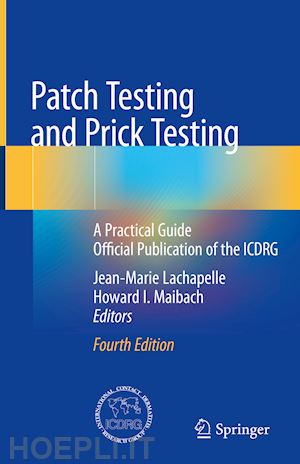Contents
Introductory Remarks
Part I Patch Testing
1 Pathophysiology of Allergic and Irritant Contact Dermatitis
1.1 Introduction
1.2 Pathophysiology of Irritant and Allergic Skin Inflammation
1.2.1 Irritant and/or Allergic Chemicals
1.2.2 Skin Irritation: Activation of Innate Immunity
1.3 Skin Allergy: The Role of Specific Immunity
1.3.1 Antigen-Specific Immunity
1.3.2 Skin Allergy: Mechanisms of Action
1.3.3 Indirect Responsibility of Chemicals in Skin Irritation
1.4 Pathophysiology of Skin Inflammation: The Connection Between Innate and Acquired Immunity
References
2 Diseases for Which Patch Testing Is Recommended: Patients Who Should Be Investigated
2.1 Allergic Contact Dermatitis
2.1.1 Clinical Signs and Symptoms
2.1.2 Histopathological Features
2.2 Allergic Contact Dermatitis Syndrome
2.2.1 Stage 1 of ACDS
2.2.2 Stage 2 of ACDS
2.2.3 Stage 3 of ACDS
2.3 Allergic Contact Dermatitis Versus Irritant Contact Dermatitis: Criteria for Differential Diagnosis
2.4 Other Skin Diseases in Which Patch Testing Is of Major Interest
2.5 Algorithmic Approach: Key Role of Patch Testing
2.6 Hand Dermatitis: Definition and Procedures Applied in Differential Diagnosis
2.6.1 Hand Dermatitis: Exogenous and Endogenous Factors
2.6.2 A Classification of Hand Dermatitis
2.6.3 Tools of Investigation
2.6.4 Hand Dermatitis: Some Examples of an Algorithmic Approach
2.6.5 Hand Eczema: A Controversial Issue
References
3 Patch Testing Methodology
3.1 Historical Background
3.2 Definition and Aims
3.2.1 Requirements for an Ideal Patch Testing Procedure
3.2.2 Is Patch Testing the “Gold Standard” to Investigate Patients with Allergic Contact Dermatitis?
3.3 Patch Test Units
3.3.1 Nonchamber Patch Tests
3.3.2 Chamber Patch Tests
3.3.3 Plastic Square Chambers
3.3.4 Reinforcement of Patch Test Units
3.4 A General Overview of Allergens
3.4.1 Allergens
3.4.2 Bioavailability of Allergens
3.4.3 Quality Control of Allergens
3.4.4 Appropriate Amounts of Petrolatum to Be Applied at Patch Testing
3.4.5 Appropriate Amounts of Liquids to Be Applied at Patch Testing
3.5 Specific Recommendations When Considering Patch Testing Patients
3.5.1 Patch Testing on Intact Skin Is Critical
3.5.2 Medicaments and Patch Testing
3.5.3 Pregnancy and Patch Testing
3.5.4 Patch Testing in Children
3.6 Application of Patch Tests on the Skin: Some Practical Suggestions
3.6.1 Test Sites
3.6.2 Removal of Hair
3.6.3 Degreasing of Test Site
3.6.4 Application of Test Strips
3.6.5 Instructions to Patients
3.7 Reading Time
3.7.1 Standard Patch Test Occlusion and Reading Time
3.7.2 Conventional Patch Test Reading Time
3.7.3 Reading at Day 2, Day 3, and Day 4
3.7.4 Reading at Day 7
3.7.5 Single Reading Versus Multiple Reading
3.7.6 Day 3 Versus Day 4 Reading
3.7.7 One-Day Occlusion Versus Two-Day Occlusion
3.7.8 Marking the Skin
3.7.9 Positive Control
3.7.10 Immediate Urticarial Reactions to Some Allergens
3.8 Reading and Scoring Patch Test Results
3.8.1 Scoring Codes According to the ICDRG
3.8.2 Proposal for Modified Scoring Codes of Positive Patch Test Reactions, According to ESCD and EECDRG
3.8.3 Rating Patch Test Reactions Based on Digital Images
3.8.4 Bioengineering Methods for Evaluating Skin Irritation and Allergic Reactions. A Comparison with Visual Scoring
3.8.5 Remarks About Reading and Scoring Patch Test Results
3.9 Irritant Patch Test Reactions
3.10 False-Positive Patch Test Reactions
3.11 False-Negative Patch Test Reactions
3.12 Compound Allergy
3.13 Cross-Sensitization, Concomitant Sensitization, and Polysensitization
3.13.1 Cross-Sensitization
3.13.2 Concomitant Sensitization
3.13.3 Polysensitization
3.14 Unwanted Adverse Reactions of Patch Testing
3.14.1 Patch Test Sensitization (“Active Sensitization”)
3.14.2 Excited Skin Syndrome (“Angry Back”)
3.15 Patch Test Readings in Different Ethnic Populations
3.15.1 Patch Test Reading in Oriental Populations
3.15.2 Patch Test Reading in Black Populations
3.16 Patch Testing Techniques in Different Climatic Environments
3.16.1 Temperate Climates
3.16.2 Tropical Climates
3.16.3 Patch Testing Procedures in the Tropics
3.17 Is Self-assessment of Allergic Contact Dermatitis by Patients Recommendable?
3.17.1 Self-assessment by Questionnaires
3.17.2 Self-readings of Patch Tests by Patients
References
4 Baseline Series of Patch Tests
4.1 Historical Background
4.2 Advantages and Disadvantages of Using a Baseline Series of Patch Tests
4.2.1 Advantages
4.2.2 Disadvantages
4.3 The Different Baseline Series of Patch Tests
4.3.1 ICDRG-Revised International Minimal Baseline Series of Patch Tests
4.3.2 The Updated 2019 European Baseline Series on Behalf of the ESCD and EECDRG
4.3.3 The Updated 20109 North American Baseline Series on Behalf of the NACDG
4.3.4 The Updated 2019 Japanese Baseline Series on Behalf of the JCDS
4.4 “Mixes” of Baseline Series
4.5 Concise Information About Allergens Included in the Updated 2011 Minimal Baseline Series of the ICDRG
4.6 Concise Information on Other Common Allergens Included in the Updated 2011 Minimal Baseline Series of the ICDRG
4.7 Additional Series of Patch Tests
4.8 The Preservative Methylisothiazolinone : The New Star of Allergic Contact Dermatitis
References
5 Photopatch Testing
5.1 Definition and Aims
5.2 Photoallergic Contact Dermatitis
5.3 Photoallergic Contact Dermatitis Versus Airborne Allergic Contact Dermatitis: Criteria for Differential Diagnosis
5.4 Photoallergic Drug Eruptions
5.5 Photopatch Testing Methodology
5.6 Light Sources
5.7 Proposal for a Photopatch Test Series
References
6 The T.R.U.E. Test® Methodology
6.1 Introduction
6.2 The T.R.U.E. Test® Methodology
6.3 More Practical Information About the Technology of The T.R.U.E. Test®
6.4 Regulatory Information
6.5 Standard The T.R.U.E. Test® Series
6.6 New Additions
6.7 Methodology of Use
6.8 Additional Information
6.9 Note
References
7 Additional Testing Procedures and Spot Tests
7.1 Strip Patch Test
7.2 Open Test
7.3 Semi-open (or Semi-occlusive) Tests
7.4 Repeated Open Application Test
7.5 Testing Procedures with Unknown Substances
7.5.1 Strategy
7.5.2 Steps Required Prior to Any Testing Procedure
7.5.3 Testing Procedures with Solid Products and Extracts
7.5.4 The Use of Ultrasonic Bath Extracts in the Search of the Culprit(s) Allergen(s) present in Solid Products
7.5.5 Testing Procedures with Cosmetics and Other Related Products
7.6 Oral Provocation Test (Oral Challenge)
7.7 Other Investigations
7.7.1 pH Measurement











